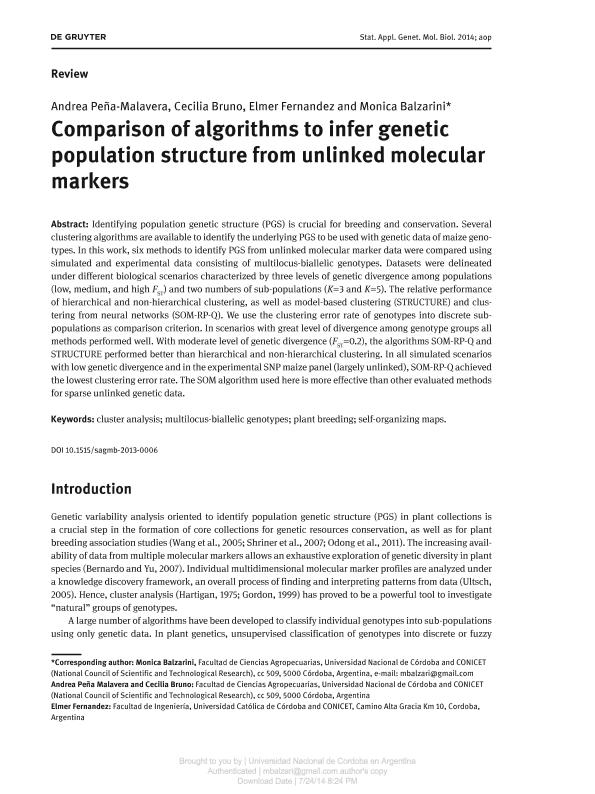Mostrar el registro sencillo del ítem
dc.contributor.author
Peña Malavera, Andrea Natalia

dc.contributor.author
Fernandez, Elmer Andres

dc.contributor.author
Bruno, Cecilia Ines

dc.contributor.author
Balzarini, Monica Graciela

dc.date.available
2018-01-23T15:20:42Z
dc.date.issued
2014-06
dc.identifier.citation
Peña Malavera, Andrea Natalia; Fernandez, Elmer Andres; Bruno, Cecilia Ines; Balzarini, Monica Graciela; Comparison of algorithms to infer genetic population structure from unlinked molecular markers; Berkeley Electronic Press; Statistical Applications In Genetics And Molecular Biology; 13; 4; 6-2014; 391-402
dc.identifier.issn
1544-6115
dc.identifier.uri
http://hdl.handle.net/11336/34261
dc.description.abstract
Identifying population genetic structure (PGS) is crucial for breeding and conservation. Several clustering algorithms are available to identify the underlying PGS to be used with genetic data of maize genotypes. In this work, six methods to identify PGS from unlinked molecular marker data were compared using simulated and experimental data consisting of multilocus-biallelic genotypes. Datasets were delineated under different biological scenarios characterized by three levels of genetic divergence among populations (low, medium, and high FST) and two numbers of sub-populations (K=3 and K=5). The relative performance of hierarchical and non-hierarchical clustering, as well as model-based clustering (STRUCTURE) and clustering from neural networks (SOM-RP-Q). We use the clustering error rate of genotypes into discrete sub-populations as comparison criterion. In scenarios with great level of divergence among genotype groups all methods performed well. With moderate level of genetic divergence (FST=0.2), the algorithms SOM-RP-Q and STRUCTURE performed better than hierarchical and non-hierarchical clustering. In all simulated scenarios with low genetic divergence and in the experimental SNP maize panel (largely unlinked), SOM-RP-Q achieved the lowest clustering error rate. The SOM algorithm used here is more effective than other evaluated methods for sparse unlinked genetic data.
dc.format
application/pdf
dc.language.iso
eng
dc.publisher
Berkeley Electronic Press

dc.rights
info:eu-repo/semantics/openAccess
dc.rights.uri
https://creativecommons.org/licenses/by-nc-sa/2.5/ar/
dc.subject
Cluster Analysis
dc.subject
Multilocus-Biallelic Genotypes
dc.subject
Plant Breeding
dc.subject
Self-Organizing Maps
dc.subject.classification
Ciencias de la Computación

dc.subject.classification
Ciencias de la Computación e Información

dc.subject.classification
CIENCIAS NATURALES Y EXACTAS

dc.title
Comparison of algorithms to infer genetic population structure from unlinked molecular markers
dc.type
info:eu-repo/semantics/article
dc.type
info:ar-repo/semantics/artículo
dc.type
info:eu-repo/semantics/publishedVersion
dc.date.updated
2018-01-22T14:18:31Z
dc.journal.volume
13
dc.journal.number
4
dc.journal.pagination
391-402
dc.journal.pais
Estados Unidos

dc.journal.ciudad
Berkeley
dc.description.fil
Fil: Peña Malavera, Andrea Natalia. Consejo Nacional de Investigaciones Científicas y Técnicas; Argentina. Universidad Nacional de Córdoba. Facultad de Ciencias Agropecuarias; Argentina
dc.description.fil
Fil: Fernandez, Elmer Andres. Consejo Nacional de Investigaciones Científicas y Técnicas; Argentina. Universidad Nacional de Córdoba. Facultad de Ciencias Agropecuarias; Argentina
dc.description.fil
Fil: Bruno, Cecilia Ines. Consejo Nacional de Investigaciones Científicas y Técnicas; Argentina. Universidad Catolica de Córdoba. Facultad de Ingeniería; Argentina
dc.description.fil
Fil: Balzarini, Monica Graciela. Consejo Nacional de Investigaciones Científicas y Técnicas; Argentina. Universidad Nacional de Córdoba. Facultad de Ciencias Agropecuarias; Argentina
dc.journal.title
Statistical Applications In Genetics And Molecular Biology

dc.relation.alternativeid
info:eu-repo/semantics/altIdentifier/doi/http://dx.doi.org/10.1515/sagmb-2013-0006
dc.relation.alternativeid
info:eu-repo/semantics/altIdentifier/url/https://www.degruyter.com/view/j/sagmb.2014.13.issue-4/sagmb-2013-0006/sagmb-2013-0006.xml
Archivos asociados
